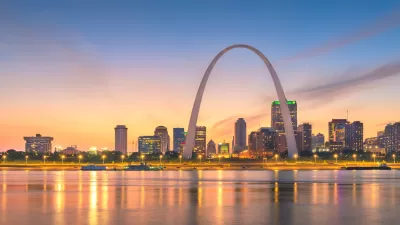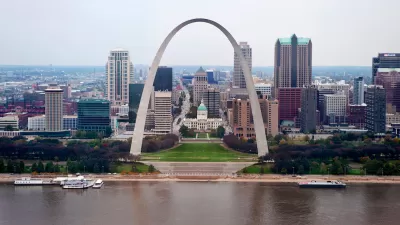Along an eight-mile corridor that runs westward from the Gateway Arch, the population has jumped 10 percent since 2000. Tim Bryant examines the ingredients that define the place "where St. Louis succeeds as a city."
Along a narrow corridor from the riverfront to Interstate 170, bounded by Delmar Boulevard to the north and Interstate 64 (Highway 40) to the south, St. Louis is experiencing an urban renaissance. Rail transit, cultural institutions, thriving businesses, civic offices, high-quality green spaces, and historic buildings are among the ingredients that add up to the place "where St. Louis succeeds as a city," writes Bryant.
"Sarah Coffin, associate professor of public policy studies at SLU, and other urban experts said the corridor’s growing vitality will continue to attract new residents who prefer to walk more and drive less. 'People’s tastes are changing about how they want to live and where they want to live,' Coffin said."
The successes of the corridor are flowing into adjoining areas as well, adds Bryant. "Experts said that central corridor development is promoting overdue growth elsewhere, particularly south to the Botanical Heights and Shaw neighborhoods and through the Forest Park Southeast area to the Grove entertainment district."
“The idea of building off success instead of leaving it as an isolated instance is taking shape,” said Zack Boyers, chief executive of St. Louis-based U.S. Bancorp Community Development Corp.
FULL STORY: Anchors and transit spur growth of St. Louis corridor

Study: Maui’s Plan to Convert Vacation Rentals to Long-Term Housing Could Cause Nearly $1 Billion Economic Loss
The plan would reduce visitor accommodation by 25,% resulting in 1,900 jobs lost.

North Texas Transit Leaders Tout Benefits of TOD for Growing Region
At a summit focused on transit-oriented development, policymakers discussed how North Texas’ expanded light rail system can serve as a tool for economic growth.

Why Should We Subsidize Public Transportation?
Many public transit agencies face financial stress due to rising costs, declining fare revenue, and declining subsidies. Transit advocates must provide a strong business case for increasing public transit funding.

How to Make US Trains Faster
Changes to boarding platforms and a switch to electric trains could improve U.S. passenger rail service without the added cost of high-speed rail.

Columbia’s Revitalized ‘Loop’ Is a Hub for Local Entrepreneurs
A focus on small businesses is helping a commercial corridor in Columbia, Missouri thrive.

Invasive Insect Threatens Minnesota’s Ash Forests
The Emerald Ash Borer is a rapidly spreading invasive pest threatening Minnesota’s ash trees, and homeowners are encouraged to plant diverse replacement species, avoid moving ash firewood, and monitor for signs of infestation.
Urban Design for Planners 1: Software Tools
This six-course series explores essential urban design concepts using open source software and equips planners with the tools they need to participate fully in the urban design process.
Planning for Universal Design
Learn the tools for implementing Universal Design in planning regulations.
Ascent Environmental
Borough of Carlisle
Institute for Housing and Urban Development Studies (IHS)
City of Grandview
Harvard GSD Executive Education
Toledo-Lucas County Plan Commissions
Salt Lake City
NYU Wagner Graduate School of Public Service





























